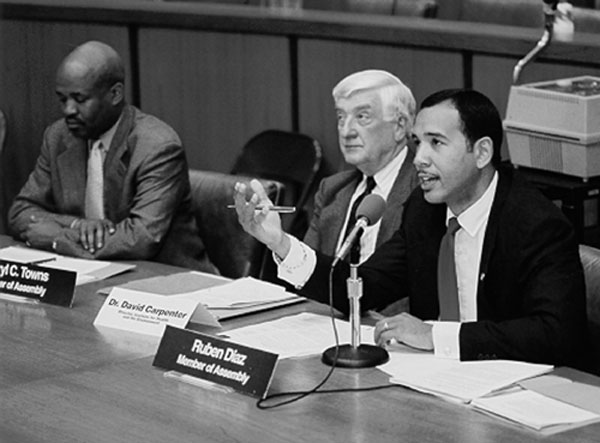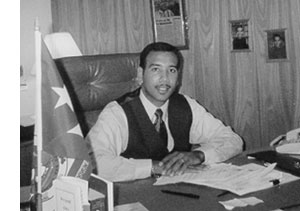|
Health effects of transportation-related pollutants
Transportation pollutants that are of particular concern to residents in urban
areas are ground-level ozone or smog and particulate matter (PM).
 Smog — Exposure to smog causes a range of human
pulmonary and respiratory health effects, including chest pain, coughing, shortness of
breath, and increased susceptibility to bacterial infections. Ground-level ozone or
smog is created when NOx and Volatile Organic Compounds (VOCs) combine in the presence
of heat and sunlight. Ozone is a powerful oxidant, capable of destroying human lung and
airway tissues.
Smog — Exposure to smog causes a range of human
pulmonary and respiratory health effects, including chest pain, coughing, shortness of
breath, and increased susceptibility to bacterial infections. Ground-level ozone or
smog is created when NOx and Volatile Organic Compounds (VOCs) combine in the presence
of heat and sunlight. Ozone is a powerful oxidant, capable of destroying human lung and
airway tissues.
 Particulate Matter — Scientific studies have linked
fine particles to a series of significant health problems including: premature death,
respiratory related hospital admissions and emergency room visits, aggravated asthma,
coughing, difficult or painful breathing, chronic bronchitis, and decreased lung function.
Fine particles that make up particulate matter air pollution (PM) are formed in the
atmosphere by chemical reactions of hydrocarbon products from the combustion of coal, oil,
gasoline, diesel, wood and industrial processes.
Particulate Matter — Scientific studies have linked
fine particles to a series of significant health problems including: premature death,
respiratory related hospital admissions and emergency room visits, aggravated asthma,
coughing, difficult or painful breathing, chronic bronchitis, and decreased lung function.
Fine particles that make up particulate matter air pollution (PM) are formed in the
atmosphere by chemical reactions of hydrocarbon products from the combustion of coal, oil,
gasoline, diesel, wood and industrial processes.
Advanced vehicle technologies*
The most promising technologies discussed at the roundtable were hybrid-electric vehicles,
fuel cell vehicles, and alternative fuel vehicles (AFV).
 Hybrid Electric Vehicle (HEV) — An HEV is powered by
the combination of a battery pack and electric motor and a power generation unit (PGU),
which is normally an internal combustion engine. Unlike electric vehicles (EVs), HEV
batteries can be recharged by an on-board PGU, which needs only to be refueled.
Hybrid Electric Vehicle (HEV) — An HEV is powered by
the combination of a battery pack and electric motor and a power generation unit (PGU),
which is normally an internal combustion engine. Unlike electric vehicles (EVs), HEV
batteries can be recharged by an on-board PGU, which needs only to be refueled.
 Alternate Fuel Vehicles (AFV) — AFVs use an internal
combustion engine to generate power like gasoline vehicles with minor modifications.
Ethanol and methanol are blended with gasoline in the vehicle’s fuel tank. The car can be
fueled on any mix of the specified alcohol and gasoline up to 85 percent alcohol.
Alternate Fuel Vehicles (AFV) — AFVs use an internal
combustion engine to generate power like gasoline vehicles with minor modifications.
Ethanol and methanol are blended with gasoline in the vehicle’s fuel tank. The car can be
fueled on any mix of the specified alcohol and gasoline up to 85 percent alcohol.
 Fuel Cell Vehicle — A fuel cell is an electrochemical
device, similar to a battery, that produces electricity silently and without combustion.
However, where batteries must be recharged to continue power generation, fuel cells must
be refueled with hydrogen.
Fuel Cell Vehicle — A fuel cell is an electrochemical
device, similar to a battery, that produces electricity silently and without combustion.
However, where batteries must be recharged to continue power generation, fuel cells must
be refueled with hydrogen.
* Definitions for all advanced vehicle technologies from "National Conference Of State
Legislatures, Ground Transportation for the 21st Century" Asme Press, August 1999.
Alternative fuels**
The Energy Policy Act of 1992 (EPAct) defines alternative fuels as: methanol, denatured
ethanol and other alcohols, separately or in mixtures of 85% with gasoline or other fuels;
compressed natural gas (CNG); liquefied natural gas (LNG); liquefied petroleum gas (LPG);
hydrogen; "coal-derived liquid fuels"; fuels "other than alcohols"
derived from "biological materials"; electricity; or any other fuel determined
to be "substantially not petroleum", and yielding "substantial energy
security benefits and substantial environmental benefits." The most promising fuels
include ethanol, natural gas, biodiesel, and hydrogen gas (H2).
 Ethanol — Ethanol is an alcohol fuel made primarily
from agricultural products, typically corn. E-85 is the primary ethanol alternative fuel.
Ethanol — Ethanol is an alcohol fuel made primarily
from agricultural products, typically corn. E-85 is the primary ethanol alternative fuel.
 Natural Gas — Natural gas is a mixture of hydrocarbons
— mainly methane (CH4). As indicated by its name, natural gas is in gaseous form. It can be
stored on a vehicle either in a compressed gaseous state (CNG) or in a liquefied state
(LNG).
Natural Gas — Natural gas is a mixture of hydrocarbons
— mainly methane (CH4). As indicated by its name, natural gas is in gaseous form. It can be
stored on a vehicle either in a compressed gaseous state (CNG) or in a liquefied state
(LNG).
 Biodiesel — Biodiesel is a fuel made primarily from the
oils and fats of plants. Although it can be used as a straight replacement to diesel, the
blend of biodiesel can be as low as 20 percent biodiesel, 80 percent diesel.
Biodiesel — Biodiesel is a fuel made primarily from the
oils and fats of plants. Although it can be used as a straight replacement to diesel, the
blend of biodiesel can be as low as 20 percent biodiesel, 80 percent diesel.
 Hydrogen gas (H2) — Hydrogen gas (H2) can be produced
from a number of different resources, including natural gas, water, and methanol. Currently,
the use of hydrogen as a vehicular fuel is still in the research and development stage.
Hydrogen gas (H2) — Hydrogen gas (H2) can be produced
from a number of different resources, including natural gas, water, and methanol. Currently,
the use of hydrogen as a vehicular fuel is still in the research and development stage.
** Definitions of Alternative Fuels from Topical Reports "Alternate Fuels for Fleet
Vehicles," Pacific Northwest Pollution Prevention Resource Center.
Alternative fuel and transportation technologies in New York State
 Hybrid Electric Vehicle — In December 2000, New York City’s
Metropolitan Transportation Authority put in a $77 million order for 200 hybrid electric transit
buses, the largest order in North America to date. The buses and their propulsion systems will be
manufactured in NYS by Orion Bus Industries and BAE Systems, respectively. (News Brief,
SustainableBusiness.com)
Hybrid Electric Vehicle — In December 2000, New York City’s
Metropolitan Transportation Authority put in a $77 million order for 200 hybrid electric transit
buses, the largest order in North America to date. The buses and their propulsion systems will be
manufactured in NYS by Orion Bus Industries and BAE Systems, respectively. (News Brief,
SustainableBusiness.com)
 Electric Postal Vans — The most successful undertaking to
date in terms of promoting a market in New York State for alternative fuel vehicles (AFV) is the
Baker Electromotive and Ford Motor Company initiative with the United States Postal Service (USPS)
to produce electric postal vans. State financial incentives brought the price of each vehicle
down enough to make them attractive to the USPS, and assembly operations were initiated at
Griffiss Business and Technology Park in Rome, New York. Ford was able to demonstrate to USPS that
the vehicle will save money in operating benefits, (no fueling stations; electricity is cheaper
than gas). The project afforded New York State the opportunity to become a leader in the
alternative fuel industry. New York is one of the few states with a meaningful tax credit to offset
the incremental costs of manufacturing an AFV, as well as a tax credit to offset the incremental
costs of buying one. Ford hopes that the USPS partnership will be a springboard for further market
development. Other countries have shown interest, so there is significant export potential.
Electric Postal Vans — The most successful undertaking to
date in terms of promoting a market in New York State for alternative fuel vehicles (AFV) is the
Baker Electromotive and Ford Motor Company initiative with the United States Postal Service (USPS)
to produce electric postal vans. State financial incentives brought the price of each vehicle
down enough to make them attractive to the USPS, and assembly operations were initiated at
Griffiss Business and Technology Park in Rome, New York. Ford was able to demonstrate to USPS that
the vehicle will save money in operating benefits, (no fueling stations; electricity is cheaper
than gas). The project afforded New York State the opportunity to become a leader in the
alternative fuel industry. New York is one of the few states with a meaningful tax credit to offset
the incremental costs of manufacturing an AFV, as well as a tax credit to offset the incremental
costs of buying one. Ford hopes that the USPS partnership will be a springboard for further market
development. Other countries have shown interest, so there is significant export potential.
Roundtable participants agreed that New York has done much to foster the growth of alternative
fuels and new transportation technologies, but hoped that more could be done. Next year, the
Commission will review other states’ efforts to promote these industries to determine if additional
incentives might be implemented in New York State, particularly in the area of diesel trucks. The
Commission will also research efforts to promote the production of alternative fuels in New York
State to determine what incentives might be needed to help manufacturers and farmers.
|


 Ruben Diaz, Jr., Vice-Chair
Ruben Diaz, Jr., Vice-Chair
 Assemblyman Diaz addresses the audience at the alternative fuel and
advanced vehicle technology roundtable. He is joined by Assemblyman
Darryl Towns (left) and keynote speaker Dr. David Carpenter (center).
Assemblyman Diaz addresses the audience at the alternative fuel and
advanced vehicle technology roundtable. He is joined by Assemblyman
Darryl Towns (left) and keynote speaker Dr. David Carpenter (center). In the coming year, the Commission will pay particular attention to ensuring the safety of our
transportation system. We will review the federal government’s new security measures to
determine if they are adequate to protect New Yorkers, and to evaluate the impact they will have
on the state’s transportation systems and the industries that depend on them.
In the coming year, the Commission will pay particular attention to ensuring the safety of our
transportation system. We will review the federal government’s new security measures to
determine if they are adequate to protect New Yorkers, and to evaluate the impact they will have
on the state’s transportation systems and the industries that depend on them.